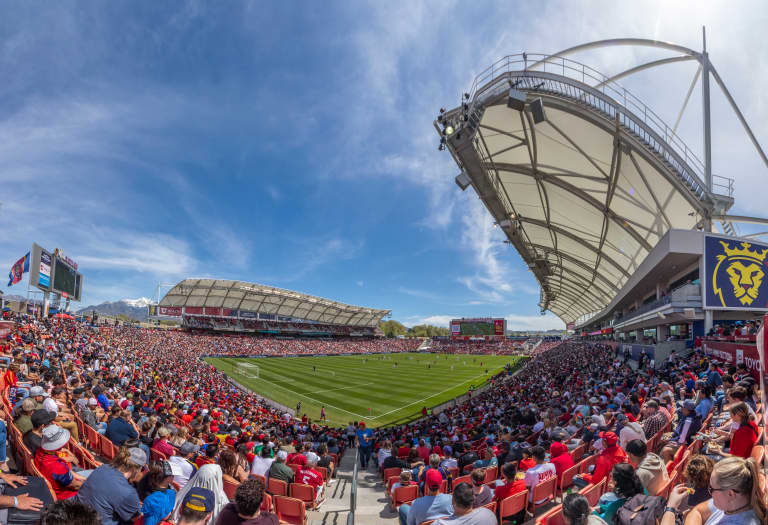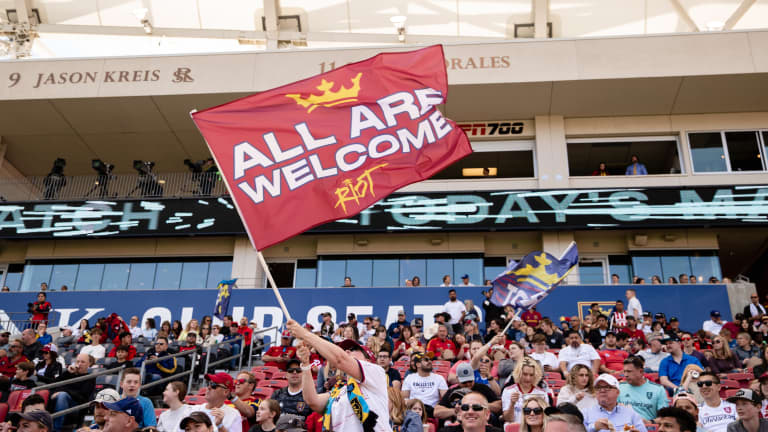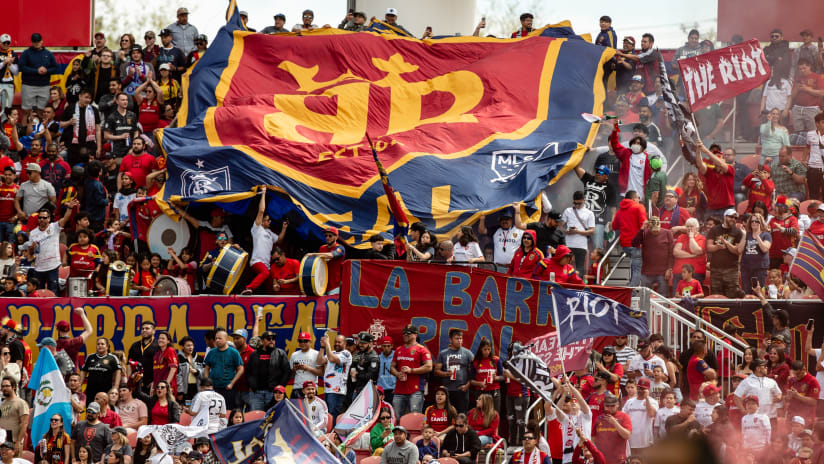Real Salt Lake are familiar with the need for orange balls in March.
Their history of snowy matches early in the MLS season is a testament to the Wasatch Front’s unpredictable spring weather. But the conditions for their 2022 home opener on March 5 were wild even by Utah standards.
Mild air over Rio Tinto Stadium gave way to rain, sleet, hail and snow in a matter of hours as a nasty storm rumbled into the Salt Lake area, knocking out power for thousands and causing dozens of auto accidents. The accompanying thunder and lightning delayed RSL’s duel with Seattle Sounders FC at Rio Tinto Stadium for two hours, throwing a meteorological wrench in the best-laid plans of new owners eager to re-introduce the club to its local community on day one.
Still, it barely put a dent in the opening-day euphoria of David Blitzer and Ryan Smith. The enthusiasm of RSL’s new owners was evident during a lengthy conversation with TV analyst Brian Dunseth during the delay, particularly about their first wave of investment, not two months after completing their acquisition of the 2009 MLS Cup winners.
“I still remember walking around this arena with Ryan six, seven weeks ago,” said Blitzer, a private-equity executive who now holds an impressive sports portfolio including stakes in RSL and half a dozen other soccer clubs across Europe, among them Crystal Palace, FC Augsburg and ADO Den Haag.
“Ryan's got a really good eye and he's pointing out X and Y, and we can change that if we fix that, and we can make a better fan experience by doing that. And frankly, John [Kimball, RSL’s president] and his team jumped on it. Yeah, there's plenty to go, but they did a really nice job in a short period.”

An organization forced to switch into “MacGyver” survival mode during more than a year of limbo in the transitory phase between owner/investors has eagerly welcomed the new guys, who arrive with deep pockets and deep connections to world soccer and the local sports landscape. They’ve already signed off on a litany of upgrades to the gameday experience at “the RioT,” some of which were in place for the opener.
“It's actually pretty crazy to look at the areas where we were pointing out – we were just riffing, we weren't even saying ‘hey, let's go do something,’” said Smith, a native son who co-founded software startup Qualtrics and explored buying RSL in 2020, only to be sidetracked for a while when he seized an opportunity to acquire the NBA’s Utah Jazz later that year.
“But I think everyone sees what it can be. And we put a little bit of investment, I would say fairly quickly in – I mean, because I think we all have a lot of ideas, but they cost money, and the team got pretty scrappy and figured out different ways to do it. And I think people are starting to experience it.”
They have big plans for their new project, and fan experience has been a main focus right out of the gates. In February RSL signed John Kimball, one of their original employees at birth back in 2004, to a multi-year deal as club president after he worked on an interim basis for more than a year. He was centrally involved in the transition from previous owner Dell Loy Hansen.
Hansen made profound investments in the club’s infrastructure, most strikingly the Zions Bank Real Academy, the sprawling $78 million facility where RSL, their second team Real Monarchs and their academy and affiliated charter school are based. But “the RioT” is now more than a decade old, and in the eyes of the new owners, ripe for a glow-up.
“We have done a lot of really exciting improvements to the building. We're kind of giving it a facelift, as much as we can with supply-chain issues, and giving a new look and feel,” Kimball told MLSsoccer.com in a one-on-one conversation earlier this year. “There's going to be a lot of exciting things that our fans haven't experienced in the past, and we put that out there as an invitation to our community to come out and support the team, but also see how the fan experience has improved.

“We also just introduced a program with UYSA, which is our local youth soccer program. There's about 57,000 kids in this market who play soccer and we've invited each and every one of those kids to come out to a game this year and bring their friends and families, and so we're excited to open that up to the community.”
One source with knowledge of RSL’s approach reckons upwards of $25 million could be spent on Rio Tinto over time, with funds already earmarked for a new pitch with upgraded under-soil heating, additional suites and expanded seating capacity, safe-standing sections and a pulley system for supporters’ tifo displays. They’re also planning to bring back the Utah Royals, the well-supported NWSL side that was sold and relocated to become the Kansas City Current in 2020.
It’s the human element that may count the most. Kimball has a number of other prominent Utah sports and entertainment entities on his résumé, including a stint in charge of the Jazz’s Vivint Arena, and he’s not been shy in importing both lessons and personnel from those experiences.
“Yes, there is synergy. I worked for the Utah Jazz for about six years, got a lot of good friends over there. Ryan Smith is a phenomenal leader who's very passionate about what we're doing; he's excited about his partnership with David Blitzer,” Kimball said.
“Where there's best practices, we of course will be looking for those. We've already started on our guest services side, we had amazing employees over at Utah Jazz when I was running that building, and we're going to use them here. They're trained very well. They treat our guests with a lot of respect. That's something that I felt could be an advantage for us here at Rio Tinto Stadium with Real Salt Lake. And that's just an example.”
This ties into what Smith calls “one Utah” – the idea that RSL, the Jazz, the local college teams and the rest of the Salt Lake City region’s sports scene can unite and inspire their community over and above being competitors for its money and attention. While not exactly a novel concept in North American sports, it might be an easier sell along the Wasatch, a proverbial “small market” with a fiercely distinct sense of identity.

“David and I walked around, we did the march, we beat the drum, we came all the way around and the whole time we're thinking ‘OK, how do we get more people involved in RSL?’” said Smith, whose investment group also includes Dwyane Wade, at the season opener. “And we've got a bunch of guests here that have never been before, from our community, tonight, and I think that's a big piece of it.”
Another example can be spotted in “Kreilach’s Corner” in the RioT’s southeast section, where captain Damir Kreilach donated a bank of 100 tickets each game to be distributed to young RSL fans from underprivileged backgrounds. Matching contributions from ownership and corporate sponsors have since pushed the section’s total number to more than 400 seats per game.
“I wanted to give something back to the community, to invite the people that can’t afford the tickets to Real Salt Lake,” said Kreilach, who credits director of community relations Kyle Schroeder for the idea. “I'm so happy as well to see a great and positive atmosphere around the club, especially the positivity by the fan base. … It's all about having the sold-out stadium.”
Salt Lake have had that indeed, selling out their first four home matches for the first time in club history, going 3W-0L-1D in those games. They’re also bullish about the business community’s response to the turning of a new era.
“For us to deliver a Western Conference Final [run] last year got our community really excited, both on the sponsorship side and on the tickets side. Regarding sponsorships, we’re pacing higher than we have in the last five years,” said Kimball.
“We've just got a positive momentum. We've got a [stadium] naming rights that's available and for sale, we've got a number of companies that are taking a look at that. And with Utah being one of the, or if not the fastest-growing population and economy in the country, there's a lot to be said about us being that small market, but being very aggressive and also evolving very quickly.”
Whenever a club changes hands, outsiders tend to focus their attention on the possibilities for “splashy” spending: The big names, high wages and fat transfer fees that are perceived to improve teams quickest and most dramatically. That’s understandable, and RSL’s new guys do have some juice; just look at Ricardo Pepi’s record-breaking move from FC Dallas to Augsburg, one of Blitzer’s other investments. Dunseth cheekily refers to a “Monopoly money” level of resources compared to the recent past.
A cursory glance at the early MLS standings might give that impression, too. A surprising 4W-2L-4D start has kept Salt Lake in the Western Conference playoff places and they sit eighth in the overall league table after their Week 9 win over the LA Galaxy.
That’s via impressive unity and over-achievement rather than a spendy roster injection of new signings, though. Head coach Pablo Mastroeni has extended the ‘plucky upstarts’ vibe from last year’s Audi 2021 MLS Cup Playoffs, weathering a severe injury crisis and notching wins over Seattle, the New England Revolution and Nashville SC, three of last year’s top sides.
That further underlines the nuanced task in front of Smith, Blitzer & Co.: How to point RSL on a rapid trajectory towards the MLS elite without unsettling the tenaciously blue-collar culture installed by the likes of Kimball and Mastroeni. The latter's work as an interim boss last year drew heavy interest from other MLS clubs with coaching vacancies before he committed his future to the Claret and Cobalt in December.
“I don't necessarily think it's about the price you pay as much as it is the quality of the human being and the quality of the player,” said Mastroeni in February. “You can get a seven-figure signing and if it just doesn't fit the ethos of the club, it won't work, right? So I think one thing that I can guarantee you is the extensive work that goes into identifying the right fit both on and off the field for the players in the locker room and how we can continue to build on some of the decisions that have been made.”
The egalitarian, academy-driven model will remain – more than half of their offseason signings were homegrowns, for example, in addition to Augsburg loanee Sergio Cordova – albeit with some bespoke upgrades, both in terms of squad reinforcements and creature comforts.
“Sooner than later there'll be a few signings that will add a lot of quality to our group,” said Mastroeni earlier this year. “Also a big part of the ownership philosophy as far as culture is concerned is making sure the workplace is somewhere everyone wants to come every day, and really grow the club from the inside out.
“So from a player's perspective, it’s a lot of little things that are on the horizon, to where the facilities aren't just a workplace but a place where you want to spend your day. Some of those in the future might include valet parking, car wash, these types of amenities that make more than just a soccer club. And also, smoothie bars, the food in the cafeteria, and the quality of those things, making sure staff has access to all these different amenities as well. And so they're really investing a lot in the culture, which I think is the most important piece.”
RSL have room to upgrade their roster – especially its top end, with two open Designated Player slots – and have broadened their target spending range on the international market.
Last week they signed Ecuadorian winger Anderson Julio, who impressed on loan from Atletico San Luis last season, scoring 9g/1a across 1,146 regular-season and playoff minutes, to a permanent deal that cost a fraction of his previous purchase option. They also completed the reacquisition of Venezuelan international Jefferson Savarino from Atletico Mineiro on the final day of the MLS Primary Transfer Window, another useful attacker who’s already demonstrated his impact in this league. Savarino's the first DP under new ownership.
Savarino was multiple millions, and Smith and Blitzer have ample means to go even bigger in the summer window. But rather than make a habit of signing LA Galaxy- or FC Cincinnati-sized checks, the new bosses envision building RSL into a stronger, more aggressive and effective version of itself.
“That can be a solution for some teams, is just to go out and buy a couple of big players. But I'll be honest, that's not the solution for our team,” contended Kimball. “Our team is founded and based on growing players and developing players. We've got, I would argue, the finest academy in the country, structurally and technically, and so we're really leaning into that.
“However, I will say that with [ownership’s] connections, with all the teams that they own across the globe, that we're looking hard. We're looking for players that fit and players that can add to what we were able to deliver last year, getting to the Western Conference finals. There's a couple positions that we need to improve on and if we can do that with a really solid, high-end player that will fit into our core group, and that's certainly a direction that our ownership is taking us.”
The surging optimism in Salt Lake cuts a contrast to the challenges of the past few years.
“Finally, after two years, to get the new ownership group, and on behalf of the team, I would say thank you again to them,” said Kreilach, “to recognize what Real Salt Lake means for the state of Utah, what it means for MLS and at the end of the day, what it means for all fans of Real Salt Lake.
“Of course now the expectation is higher – especially, hopefully the team is going to go the great things as we did last year, if not even better,” he added. “But I mean, the people around the club, the fan base, everyone is positive, and this is how the team acts. And actually the players are going to try to deliver something special on the field. Now it's up to us to put hard work, to be positive, to stick together and to deliver the results.”

New management often leads to new identities in modern soccer, with rebrands a recurring tactic to reflect the turn of the page. But those speculating about such a move in Salt Lake should consider Kimball’s thorough disassembling of that notion when it was posed to him.
“I don't think so. I think there's a lot of history in our brand,” said RSL’s president, who Smith has praised for his “pressure leadership” during the changeover. “Dave Checketts originally founded that brand and it was a tie and a relationship with Real Madrid, and I think our community loves our brand and we're certainly proud of it. So there hasn't been conversations of that on our side.
“The history on the colors is that BYU is blue, which is one of the biggest [area] colleges, and then the University of Utah is red. And so with that in mind, we can invite anybody in this market to a game and they can wear their colors for Real Salt Lake. So I think there's a lot of history and a lot of strategy behind why we're blue and red and why we have our brand. And it's a phenomenal story. I mean, to have Real Madrid come here and play in front of 45,000 fans back in the day, I think is part of our history and something we're very proud of.”
Whatever outsiders may think of those regal trappings copped from distant Spain, they now have nearly two decades’ worth of roots and memory dug into Sandy’s loam, not unlike Smith’s beloved basketball team with the New Orleans-flavored name.
“No Jazz fan needs to explain to me what it's like to be a Jazz fan. I've been on this ride for my whole life. Like, I promise I have been there as much as you have. There's nothing I want more,” said Smith with a grin last month. “And it's the same with David, and we’re bringing that to RSL. That doesn't mean we have unlimited budget, it doesn't mean that other groups aren't trying to win … but I think the overall messaging is the competitiveness here is thick.”
He and Blitzer stress that they want to approach RSL as supporters first, and business operators second, and serve their fellow fans from that place as well.
“We're really competitive people,” said Blitzer, “who want to win yesterday, today, tomorrow.”










